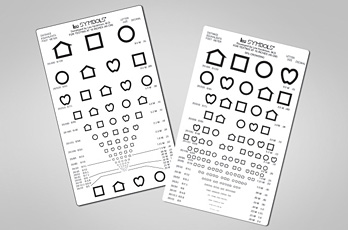LEA SYMBOLS®
Near Vision Pocket Card
#250950
When you want to measure visual acuity values quickly and less exactly than with the standard near vision card (#250800) with its cord to hold the test at the correct distance, you can use the small pocket card and hold it at approximately 40 cm (16 inches). The name pocket card refers to the original use of this test during rounds at the hospitals.

-
Decide together with the child which names the child wants to give to the four symbols or - if the child does not want to or cannot talk - choose pointing at the large symbols on the response cards or the keycard as a matching game.
-
To measure the binocular vision, show the card at the distance of 40 cm (16 inches) and ask the child to identify the first symbol on the largest row, then the first symbol on the second, third and fourth row, and so on until the child makes an error. The easiest way to make sure that the child knows which row to look at is to cover the line above the line you want the child to read with the blank side of your business card. When moving to a new line, support the child by asking: “What is the first picture?” The child may answer "house". Then you ask: “What is the picture next to the house?” Do not point to the optotypes. You may briefly point to the next optotype, but do not leave the pointing finger at the optotype because pointing makes it easier to fixate on the symbol.
-
In the rare case that the child is myopic and thus accustomed to looking at a close distance, test at a distance of 20 cm (8 inches). The visual acuity value is then one half of the value printed at the line that the child can read correctly the majority of optotypes.)
-
When the child makes an error, move up one line and ask the child to read the whole line.
-
Visual acuity is the value of the line on which the child correctly reads at least three out of the five symbols.
-
The monocular values are measured the same way by first occluding the left eye and then the right eye. Ensure that the child does not peek during monocular screening.
This test is often useful during the first examination of a person with dementia because letters and numbers may have become forgotten but pictures of concrete objects usually remain much longer. With dementia, numbers are often forgotten first, followed by letters, and then pictures of concrete objects. The way of answering is decided based on the person’s easiest way of communicating.
[ Instructions I Paediatric Vision Tests I Vision Tests ]
This document was last modified on